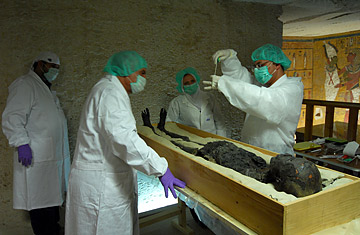
Researchers sample DNA of royal mummies, including that of King Tut, in the Valley of the Kings, on the West Bank of Luxor, Egypt
Carsten Pusch, a medical geneticist with a special interest in ancient diseases, never imagined he'd be called in to help autopsy one of history's oldest and most internationally celebrated corpses. But that's just what happened when Zahi Hawass, the legendary director of Egypt's Supreme Council of Antiquities, rang him up at his offices in the University of Tübingen in Germany.
Would Pusch be interested, asked Hawass, in doing a DNA analysis on several mummies from the 18th Dynasty — including a king who died before he reached the age of 20 and who went by the name of Tutankhamen?
After swallowing hard — "I never worked with royal mummies before," he says — Pusch agreed. Now, 2½ years later, the results of the inquiries are in, in the form of a paper in the Journal of the American Medical Association, published on Tuesday.
Among the results: King Tut was probably not murdered, despite some popular theories to the contrary. And he probably didn't suffer from a long list of diseases that experts have speculated about, including, as the report lists them (deep breath), "Marfan syndrome, Wilson-Turner X-linked mental retardation syndrome, Fröhlich syndrome, Klinefelter syndrome, androgen insensitivity syndrome, aromatase excess syndrome in conjunction with sagittal craniosynostosis syndrome or Antley-Bixler syndrome or a variant form."
What probably did Tut in, says Pusch, was an immune system that was badly compromised by a particularly virulent strain of malaria combined with a degenerative bone disease that had already left him weak. "This is confirmed by images that show him sitting while shooting an arrow, which normally would have been done standing up," says Hawass. "He cannot stand." Indeed, more than 100 canes were found in the tomb when Tut's mummy was found in 1922, some of them showing signs of wear.
"Death, [the authors] assert, was not attributable to foul play; rather a sudden fracture of the leg (perhaps resulting from a fall) progressed to a life-threatening condition because of his malarial infection," wrote Howard Markel of the Center for the History of Medicine at the University of Michigan, in an editorial accompanying the study.
The DNA also showed that feminized artistic depictions of Tutankhamen and Akhenaten, Tut's father and predecessor, with breasts were only that: there was no evidence of hormonal imbalances that could have resulted in the real thing. The relevant areas of both mummies are missing, which has hitherto made it impossible to settle the question. (Tut's penis, however, which is present though not attached to the body, is "well developed," according to the paper, casting further doubt on the theory of hormone problems.)
But that's only the beginning of what Pusch and his colleagues found, working in a state-of-the-art lab funded by the Discovery Channel, which will present a two-part special based on the research starting Feb. 21.
The researchers' X-rays revealed, for instance, that several chronic disorders evidently plagued Tut and many of his relatives, including clubfoot, cleft palate and curvature of the spine.
Even more important is the fact that the DNA analyses put names to several of the unidentified mummies in the ancient Egyptian collection. By looking at overlaps in the subjects' genomes, the scientists were able to put together a plausible family tree. For example, they were able to identify a mummy known only as KV55 as probably being Akhenaten, the controversial pharaoh who radically reinvented Egyptian society. "It's really incredible," says Pusch, "that we've given a name to what was an anonymous mummy."
Another mummy, known as KV35YL, was identified as both the sister of Akhenaten and the mother of Tutankhamen, meaning that Tut was the product of a brother-sister coupling. "She cannot be Nefertiti," says Hawass, citing another popular speculation that Nefertiti, Akhenaten's chief consort, was Tut's mother, "but she can be any of the five daughters of Amenhotep [Akhenaten's father]."
There's plenty more, but even though the new study fills 10 journal pages, it barely scratches the surface of what's possible. "The Egyptians have a trove of unidentified royal mummies," says Pusch. "With enough resources, we could work on members of 50 different dynasties." The embalming protocol preserved DNA beautifully, he says. "The ancient priests had no idea they were being so helpful."
